You’ve probably noticed how some plants struggle in Georgia’s unpredictable weather, while others seem perfectly at home. Native species have spent thousands of years adapting to the state’s humid summers, occasional droughts, and clay-heavy soils. They’ll save you money on water bills, require less maintenance, and support local wildlife better than exotic alternatives. But choosing the wrong native plant for your specific location can still lead to disappointing results.
Contents
Georgia’s Climate and Soil
When you’re planning a native plant garden in Georgia, understanding the state’s humid subtropical climate becomes your foundation for success. You’ll encounter significant climate variability across the state, from coastal areas averaging 60°F winters to northern mountains reaching 50°F. Summer temperatures hit the upper 80s to 90°F statewide. Northern regions receive 75 inches of annual precipitation, while southern areas get 50 inches.
This creates diverse soil types, from well-draining mountain soils to moisture-retentive coastal plains. Your elevation ranges from sea level to 4,700 feet, creating distinct microclimates that influence which native species will thrive in your specific location. The influence of maritime tropical air masses creates the warm, humid conditions that characterize Georgia’s summer growing season.
Georgia’s Best Wildflowers
Georgia’s diverse wildflowers showcase stunning blooms across seasons, from spring ephemerals in woodlands to fall-blooming meadow species, offering both ornamental beauty and essential ecological benefits. These regionally-adapted plants provide natural pest resistance and environmental tolerance while supporting local wildlife and creating vital habitats.
Georgia Aster
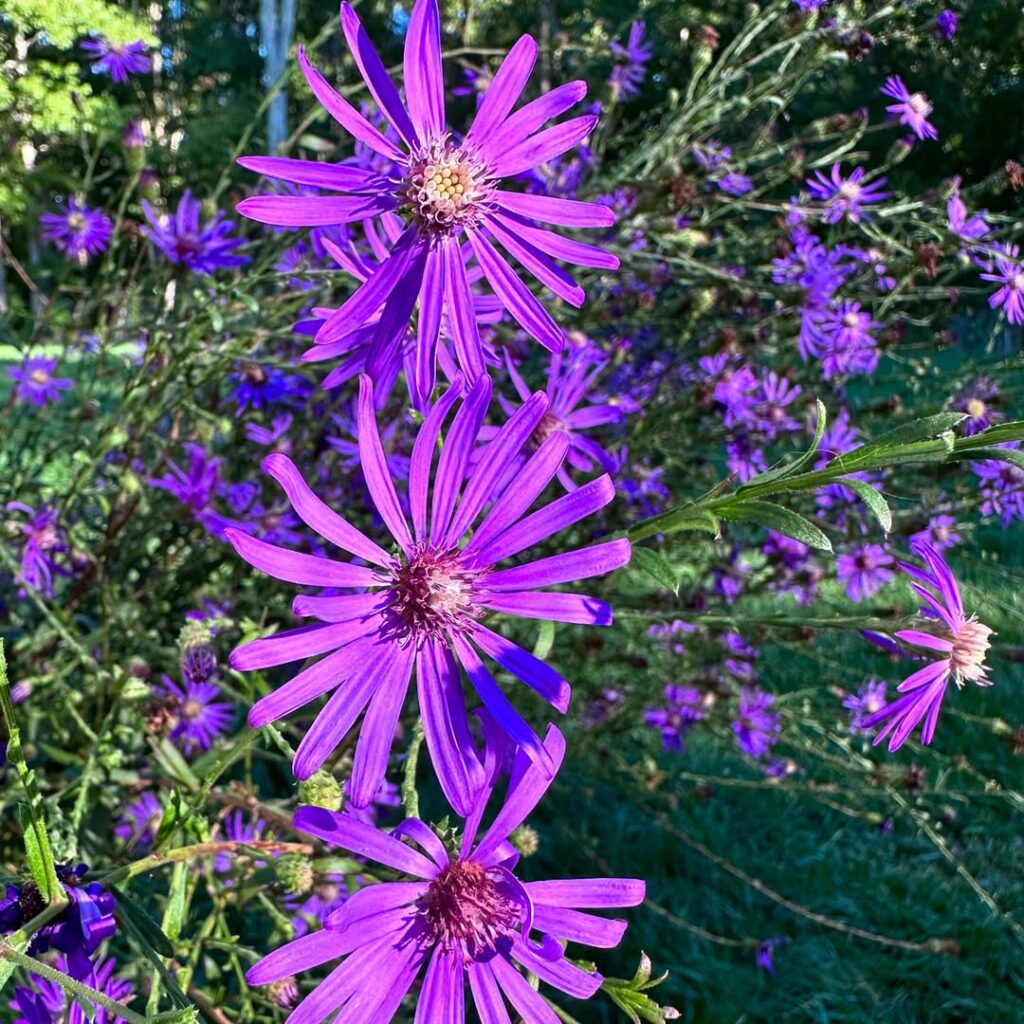
Georgia Aster is a rare perennial wildflower native to the Southeastern United States, particularly Georgia, Alabama, and the Carolinas. This member of the Asteraceae family produces stunning deep violet flowers with narrow petals in mid-to-late fall, providing vital late-season color when most other wildflowers have finished blooming. Growing 1-3 feet tall in spreading clumps, it was named Georgia Native Plant Society’s Plant of the Year in 2015.
Once common in dry, open woodlands and old fields, Georgia Aster has become rare in the wild due to habitat loss and fire suppression. However, it’s increasingly available at native plant nurseries and proves relatively easy to cultivate in the right conditions, making it valuable for restoration projects and pollinator gardens. The plants support specialized bees from the genus Andrena and Colletes, making them particularly valuable for native pollinator conservation.
- Hardiness: Zones 5-9
- Light: Full sun to minimal shade; more sun produces more blooms
- Water: Low to moderate; drought tolerant once established
- Soil: Well-drained, acidic sandy or clay soils; dislikes wet conditions
- Fertilizer: Low requirements; thrives in average garden soils
- Pest/Disease Resistance: Generally resistant with minimal issues
- Growth Rate: Moderate; spreads by underground rhizomes
Black-Eyed Susan
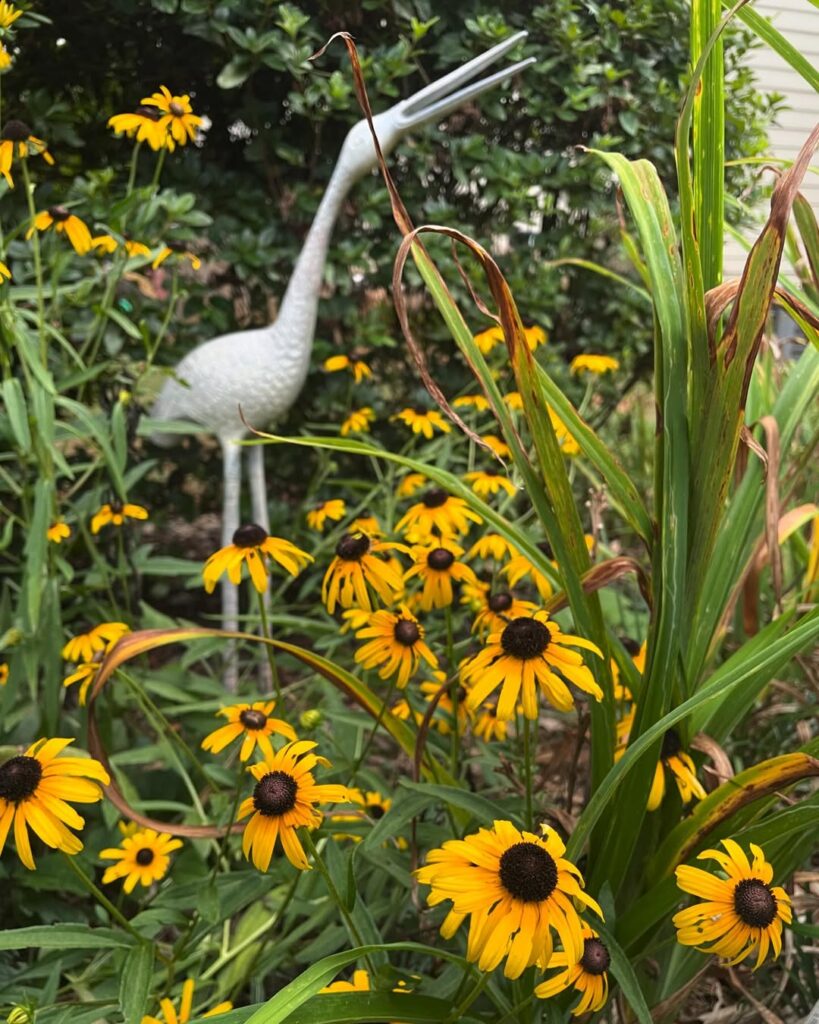
Black-Eyed Susan is a cheerful native wildflower that brings vibrant yellow blooms to Georgia gardens from June through October. This adaptable perennial produces distinctive daisy-like flowers with dark brown centers, reaching heights of 2-3 feet. Native throughout Georgia’s prairies, meadows, and woodland edges, Black-Eyed Susan thrives in diverse conditions and provides essential food for pollinators and birds.
This low-maintenance wildflower excels in naturalized settings and pollinator gardens, spreading readily in favorable conditions. Its drought tolerance and deer resistance make it ideal for Georgia’s climate, while its long blooming season guarantees months of continuous color. The plant adapts well to both formal garden borders and wild meadow plantings. The flowers attract butterflies and bees along with other beneficial insects that rely on their nectar.
- Hardiness: Zones 3-9, grows as annual, biennial, or short-lived perennial in Georgia
- Light: Full sun (minimum 6 hours daily); tolerates partial shade with afternoon protection
- Water: Medium water needs; drought tolerant once established; avoid overwatering
- Soil: Well-drained, moist to dry soils; adapts to sandy or clay; prefers organic-rich conditions
- Fertilizer: Thrives in nutrient-rich soil; acidic pH preferred (below 6.8)
- Pest/Disease Resistance: Few serious problems; deer resistant
- Growth Rate: Can be aggressive spreader in favorable conditions with little competition
Purple Coneflower
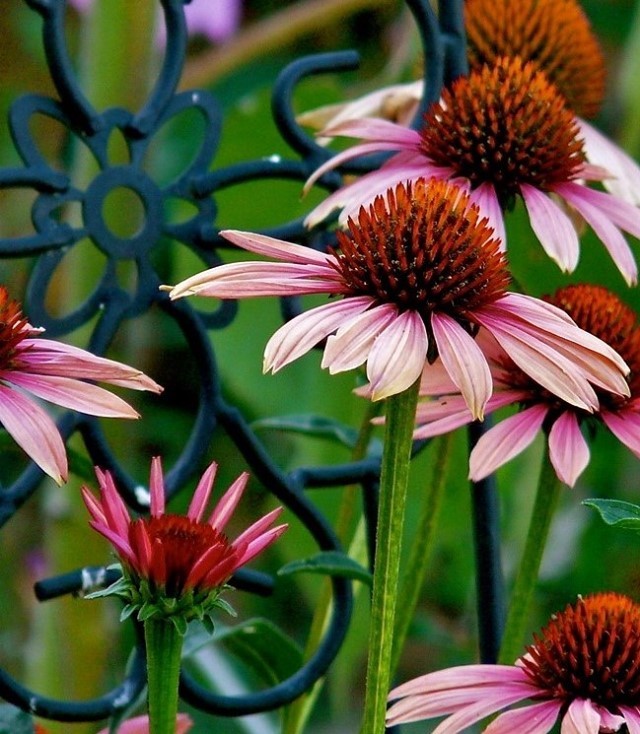
Purple coneflower (Echinacea purpurea) is a beloved native wildflower that brings vibrant purple-pink blooms and distinctive spiny central cones to Georgia gardens from late spring through late summer. Growing 2-4 feet tall with an upright habit, this drought-tolerant perennial thrives in the state’s hot climate while providing essential resources for pollinators like bees and butterflies.
Unfortunately, *Echinacea laevigata* is listed as endangered in Georgia due to habitat loss, with only four populations remaining in open woodlands and limestone bluffs. This hardy wildflower serves as an excellent choice for naturalized plantings, offering long-lasting color, wildlife value, and remarkable resilience once established. The plant’s sturdy stems require no staking, making it a low-maintenance addition to perennial gardens.
- Hardiness: Heat and drought tolerant once established
- Light: Full sun to partial shade
- Water: Moderate moisture when establishing; drought tolerant thereafter
- Soil: Well-drained, enriched with compost; tolerates shallow, rocky soils
- Fertilizer: Minimal needs; annual slow-release fertilizer or compost application
- Pest/Disease Resistance: Good resistance; deer resistant due to rough texture
- Growth Rate: Moderate; reaches 2-4 feet tall, spreading 20-28 inches wide
Wild Bergamot

Wild Bergamot, scientifically known as Monarda fistulosa, is one of Georgia’s most beloved native wildflowers and a member of the mint family. This aromatic perennial produces distinctive tubular flowers that serve as magnets for butterflies, bees, and other pollinators, earning it the common name “Bee Balm.” Native to Georgia and most of the eastern United States, Wild Bergamot thrives in diverse habitats from dry open woods to wet meadows.
The plant’s fragrant foliage releases the scent of thyme when crushed, and it spreads naturally through underground rhizomes to form attractive colonies. Wild Bergamot’s adaptability and wildlife value make it an excellent choice for naturalized areas, pollinator gardens, and even container plantings where its spreading habit can be controlled. The dried seed heads provide food for birds during the winter months, making this plant valuable for year-round wildlife support.
- Hardiness: Heat tolerant and moderately drought resistant, suitable for Georgia’s climate
- Light: Full sun to partial shade
- Water: Adaptable to both dry and moist soil conditions
- Soil: Various soil types including sand, loam, clay, acidic, and alkaline soils with good drainage
- Fertilizer: Low maintenance, no special fertilizer requirements
- Pest/Disease Resistance: Susceptible to powdery mildew but rarely causes serious damage
- Growth Rate: Spreads aggressively through rhizomes, requires division every 2-3 years
Wild Columbine
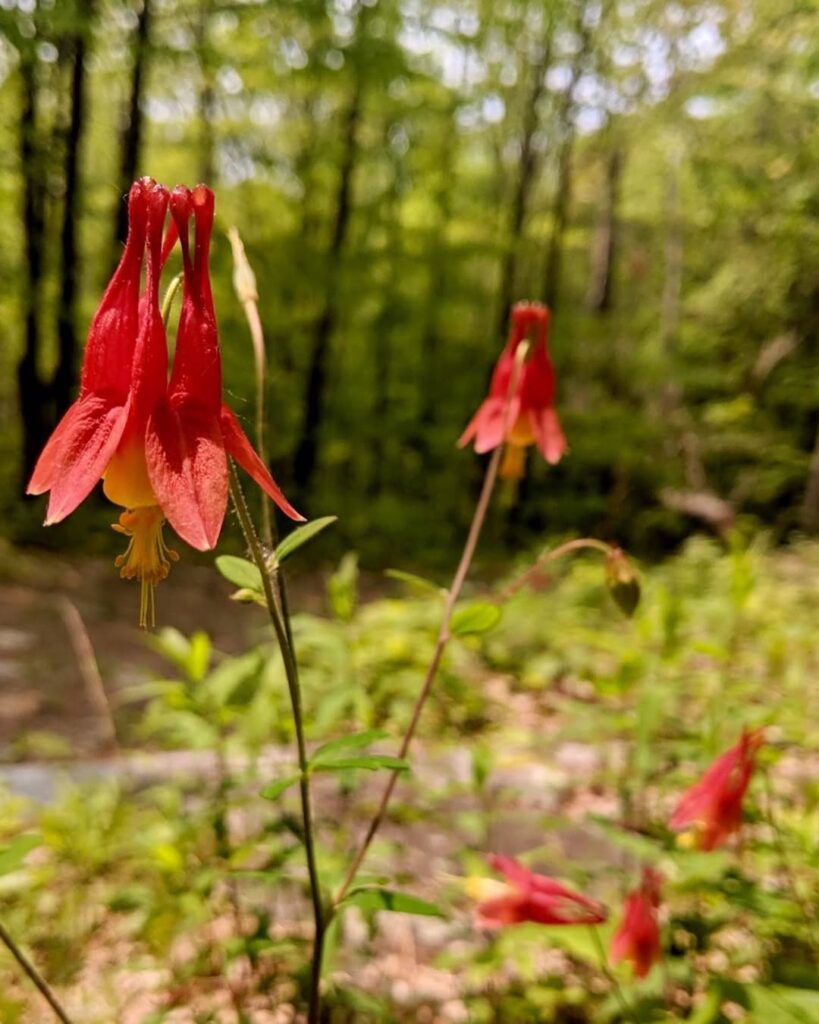
Wild Columbine stands out as one of Georgia’s most charming native wildflowers, featuring distinctive nodding blooms with bright yellow petals and contrasting red spurs that create an enchanting display in woodland gardens. This hardy perennial reaches up to 3 feet tall and produces its showy flowers from late spring through early summer, followed by ornamental seed pods that extend the plant’s visual appeal.
The blue-green foliage provides attractive texture throughout the growing season, with outer leaves turning brilliant crimson as fall approaches. Wild Columbine thrives in Georgia’s shaded woodland areas and makes an excellent addition to native plant gardens, offering reliable early-season color and supporting local wildlife. The plant develops a tap root system that helps it establish well in woodland conditions and contributes to its drought tolerance once mature.
- Hardiness: USDA Zones 3a-8b
- Light: Partial shade to full shade
- Water: Moist to occasionally dry conditions
- Soil: Well-draining, adaptable to clay, loam, or sand; prefers neutral pH 6.0-8.0
- Fertilizer: Low requirements, thrives in native conditions
- Pest/Disease Resistance: Generally resistant with good air circulation
- Growth Rate: Moderate, self-seeds readily in suitable conditions
Georgia’s Champion Native Trees
Georgia’s Champion Tree Program recognizes the state’s largest native specimens, measuring exceptional trees across diverse regions while highlighting their ecological value and genetic importance. Trees must meet strict minimum circumference requirements of 9.5 inches at 4.5 feet from the ground and stand at least 13 feet tall with a formed crown to qualify for champion status.
Southern Live Oak
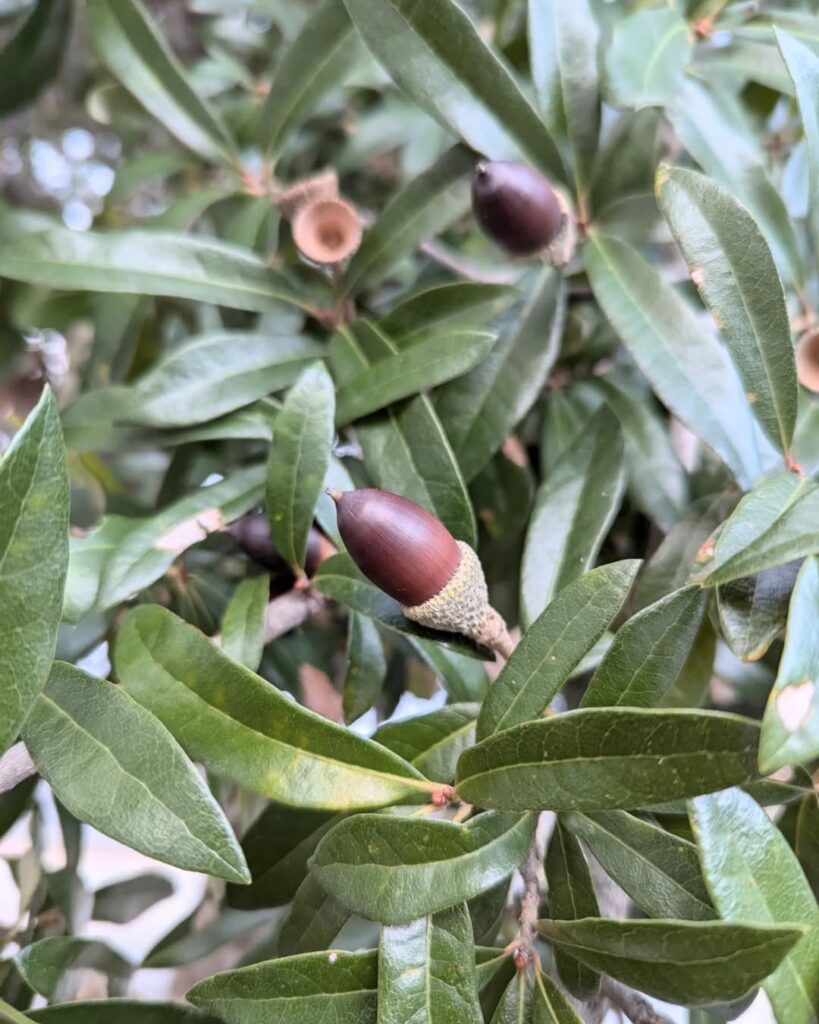
The Southern Live Oak stands as Georgia’s most iconic native tree and official state tree, reaching impressive heights of 80 feet with sprawling canopies up to 100 feet wide. This majestic evergreen oak creates distinctive Southern landscapes with its drooping branches often draped in Spanish moss, dark green elliptical leaves, and broad, dense canopy. Endemic to the Southeastern United States, it serves as a symbol of heritage and hospitality while providing essential ecological benefits.
With exceptional longevity of up to 400 years, the Southern Live Oak offers unmatched landscape value and environmental adaptability. Its extensive root system contributes to soil stabilization while supporting diverse wildlife species across multiple habitats from maritime forests to grasslands. The tree’s remarkable resilience to harsh conditions, combined with its fast growth rate when young, makes it an outstanding choice for Georgia landscapes. The fire-resistant crown and root system allow the tree to survive wildfires that would destroy other species.
- Hardiness: USDA Zones 8-10, highly drought tolerant and resistant to breakage
- Light: Full sun to partial shade
- Water: Tolerates both occasionally wet and well-drained conditions; drought tolerant once established
- Soil: Adaptable to clay, sand, loam, alkaline, and acidic soils
- Fertilizer: Low maintenance; typically does not require regular fertilization
- Pest/Disease Resistance: Generally resistant to most pests and diseases; high aerosol salt tolerance
- Growth Rate: Fast-growing when young (1 inch caliper and 2-4 feet per year)
Bald Cypress
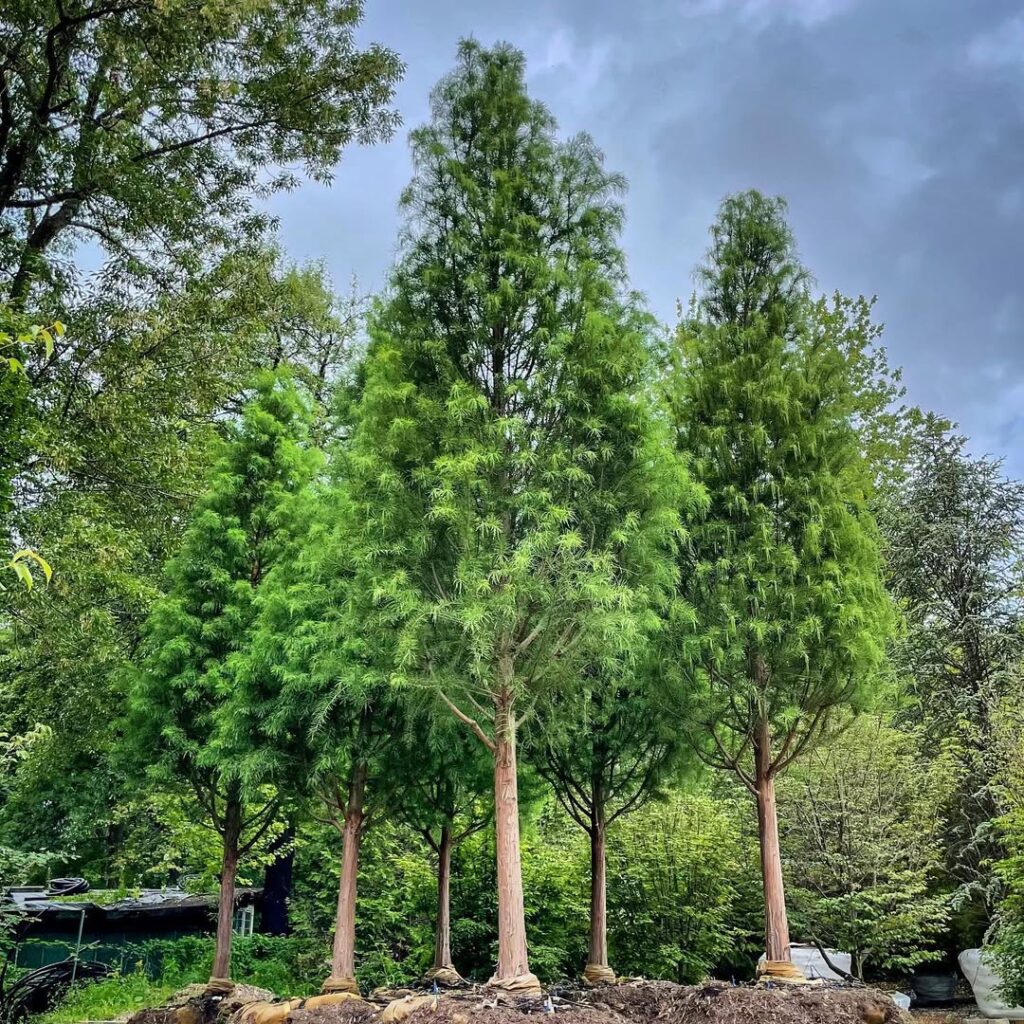
The Bald Cypress stands as one of Georgia’s most distinctive native conifers, renowned for its unique ability to thrive in wetland environments while developing characteristic “knees” around its buttressed trunk. This deciduous conifer creates stunning seasonal interest with feathery yellow-green foliage that transforms to brilliant cinnamon orange-brown in autumn.
As a champion native tree, Bald Cypress offers exceptional ecological value, providing wildlife habitat while hosting beneficial insects and caterpillars. Its water-resistant lumber and distinctive pyramidal form make it both ecologically and economically significant. The tree’s Spanish moss adornment in southern regions adds to its iconic southern landscape appeal. The species exhibits remarkable decay resistance, making it highly prized for both heavy construction projects and ornamental landscaping applications.
- Hardiness: USDA Zones 4-9, well-adapted to Georgia’s climate
- Light: Full sun to part sun
- Water: Moist to wet conditions, excellent for waterlogged areas
- Soil: Acidic, well-draining to wet soils; avoid alkaline conditions
- Fertilizer: Low maintenance, minimal fertilization needed once established
- Pest/Disease Resistance: Generally resistant with few serious issues
- Growth Rate: Moderate, reaching 50-70 feet tall with 20-45 foot spread
Sweetgum Tree

The American sweetgum stands as one of Georgia’s most recognizable native trees, thriving throughout the state except at high elevations. This impressive deciduous tree reaches heights of 75-130 feet with distinctive star-shaped leaves that transform into brilliant displays of red, purple, and maroon each fall.
Known for its spiky “gumball” fruits and rapid growth, sweetgum dominates many Georgia Piedmont forests and readily colonizes disturbed areas through both seed dispersal and vigorous root sprouting. While valued for its lumber and ornamental qualities, the persistent spiky fruits can be problematic in residential landscapes. The tree serves as an important host plant for over 30 species of butterflies and moths, including the luna and promethea moths.
- Hardiness: Warm temperate zones, thrives throughout Georgia except high altitudes
- Light: Full sun for ideal growth
- Water: Prefers moist conditions, adaptable to various moisture levels
- Soil: Moist alluvial clay and loamy soils preferred, but grows on wide range of Piedmont and Coastal Plain soils
- Fertilizer: Generally not required, thrives in native soil conditions
- Pest/Disease Resistance: Generally hardy with good natural resistance
- Growth Rate: Rapid growth, highly competitive colonizer
Flowering Dogwood Tree
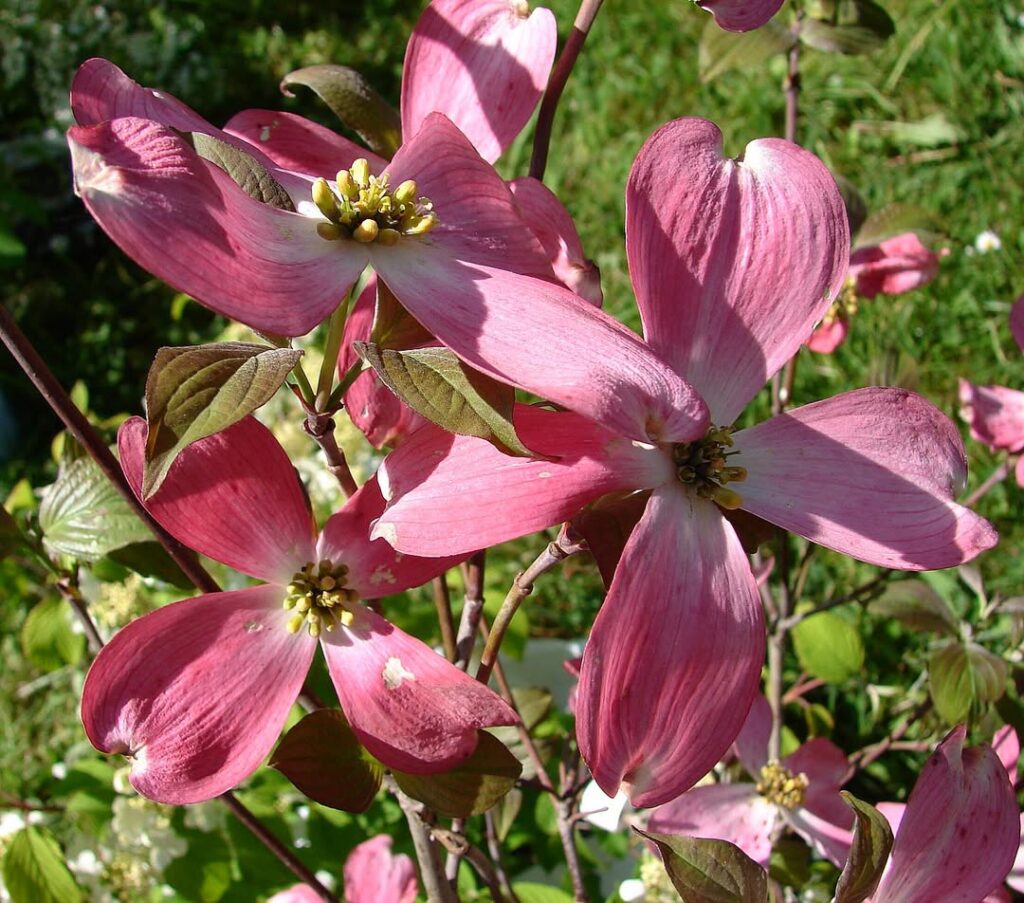
The Flowering Dogwood stands as one of Georgia’s most beloved native trees, naturally occurring throughout all 159 counties. This understory tree typically reaches 20-30 feet in height with distinctive horizontal-tiered branching that creates an elegant garden specimen. Its showy white or pink spring blooms appear in early April, followed by brilliant scarlet fall foliage and red berries.
Beyond its ornamental appeal, the Flowering Dogwood serves essential ecological functions as a wildlife food source and nesting habitat. The tree produces fruits called dogberries that provide sustenance for various wildlife species throughout the season. Historically significant to Native Americans and valued for its shock-resistant wood, this iconic Southern tree remains widely planted in residential and public landscapes across Georgia.
- Hardiness: Zones 5-9, thrives throughout Georgia’s climate
- Light: Partial shade preferred; tolerates some sun but flowers less in heavy shade
- Water: Regular watering during establishment; prefers consistent moisture
- Soil: Rich, well-drained, acidic soils; benefits from mulched locations
- Fertilizer: Minimal requirements in native soil conditions
- Pest/Disease Resistance: Improved cultivars available for enhanced disease resistance
- Growth Rate: Moderate growth rate to mature size
Redbud Tree
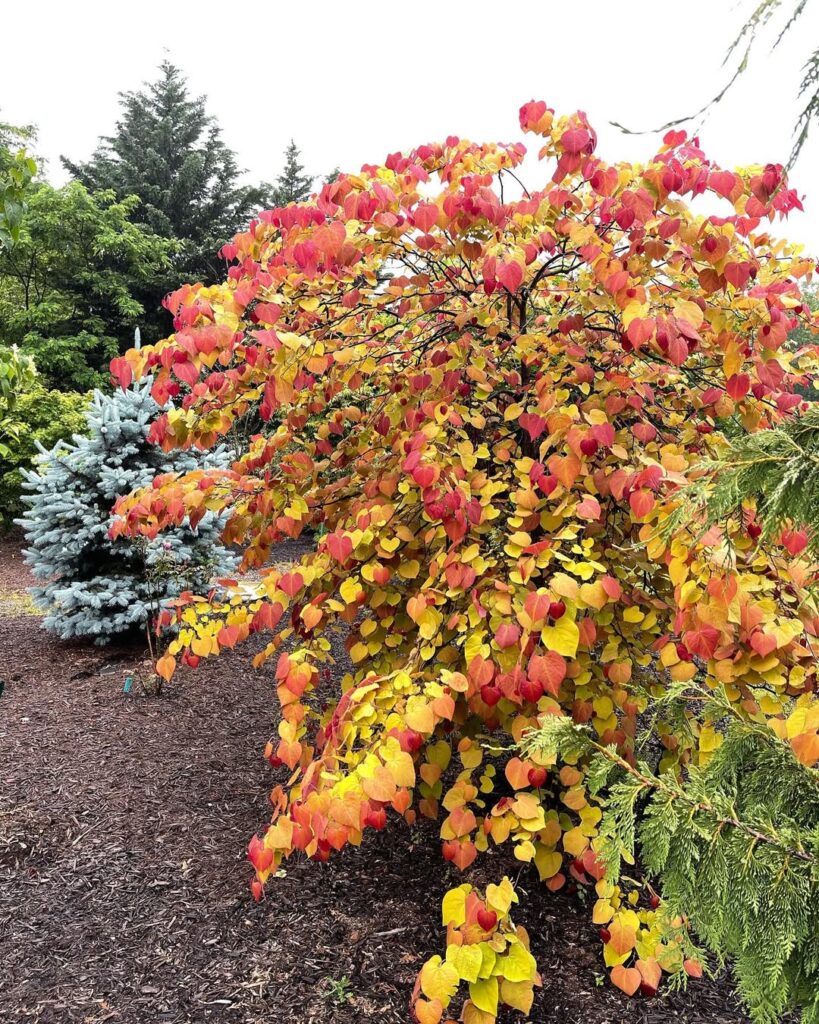
The Eastern Redbud (Cercis canadensis) stands as one of Georgia’s most beloved native trees, earning recognition for its spectacular early spring display of pink to magenta flowers that emerge on bare branches before leaves appear. This small deciduous tree typically reaches 20-30 feet in height with an equally broad spread, making it perfect for residential landscapes and understory plantings.
Beyond its stunning floral show, the Redbud offers year-round interest with distinctive heart-shaped leaves and provides essential ecological benefits. It serves as an important nectar source for early-season pollinators, supports local wildlife with its seed pods, and functions as nesting habitat for birds. The tree’s attractive winter silhouette makes it particularly striking when planted against light-colored walls or buildings. Notable cultivars like ‘Forest Pansy’ and ‘Hearts of Gold’ offer unique foliage colors, expanding design possibilities for Georgia gardeners.
- Hardiness: USDA Zones 4-9A, suitable throughout Georgia
- Light: Full sun to partial shade; afternoon shade preferred in intense heat
- Water: Moderate; regular watering during establishment, drought tolerant once established
- Soil: Well-drained soils; adapts to various soil types, prefers pH-neutral to slightly alkaline
- Fertilizer: Minimal requirements; benefits from organic mulch
- Pest/Disease Resistance: Generally good; monitor for borers and fungal leaf spots
- Growth Rate: Moderate
Georgia’s Premier Native Shrubs
Georgia’s diverse climate zones from mountains to coast support an impressive array of native shrubs, including popular deciduous varieties, evergreen species, specialized habitat plants, and regionally specific specimens. These native shrubs offer low-maintenance gardening solutions that are naturally adapted to local conditions and require minimal intervention once established.
Spicebush
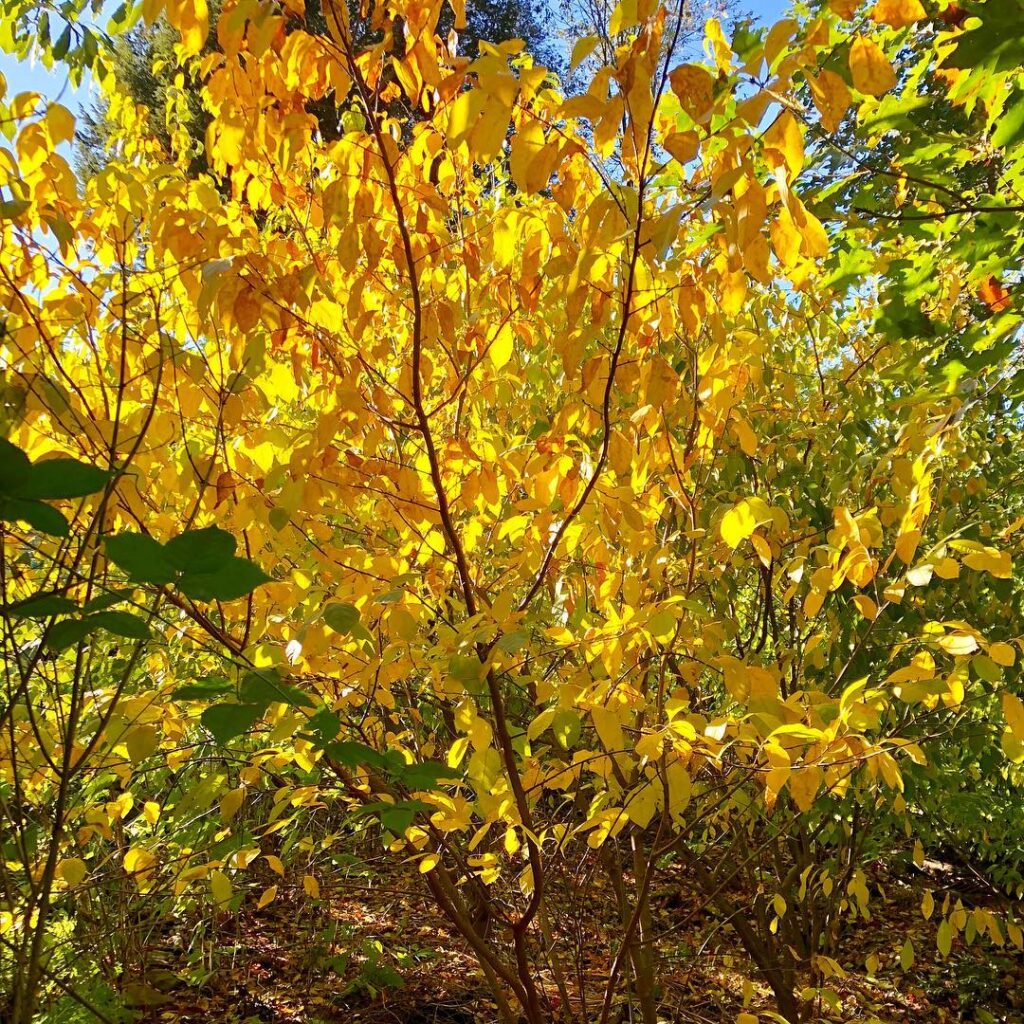
Spicebush stands out as one of Georgia’s most valuable native shrubs, offering year-round interest and exceptional ecological benefits. This aromatic member of the laurel family produces clusters of small greenish-yellow flowers in early spring before the foliage emerges, followed by bright red fruits on female plants that provide food for wildlife.
The shrub’s distinctive spicy-scented leaves turn brilliant yellow in fall, while its naturally rounded form makes it an excellent choice for naturalized landscapes. As a host plant for swallowtail butterfly larvae and a nectar source for pollinators, spicebush plays a significant role in supporting Georgia’s native wildlife while adding fragrant beauty to woodland gardens and streamside plantings. The aromatic foliage and twigs can also be harvested to make a flavorful herbal tea.
- Hardiness: USDA zones 4-9
- Light: Part shade to full shade; tolerates full sun with adequate moisture
- Water: Consistent moisture preferred; requires more frequent watering in sunny locations
- Soil: Moist, well-drained soils; bog spicebush prefers peaty-mucky wetland soils
- Fertilizer: Low maintenance; thrives without supplemental fertilization
- Pest/Disease Resistance: Generally pest and disease free
- Growth Rate: Moderate; reaches 6-12 feet tall and wide at maturity
Oakleaf Hydrangea

The Oakleaf Hydrangea stands as one of Georgia’s most outstanding native shrubs, discovered in Crawford County in 1775 by William Bartram. This multi-stemmed, deciduous shrub reaches 3-12 feet tall with distinctive oak-like leaves and showy pyramidal flower clusters that shift from greenish to white to purplish hues. The plant offers exceptional four-season interest with bold summer foliage, spectacular fall colors ranging from deep red to burgundy, and attractive exfoliating bark that provides winter structure.
Beyond its ornamental value, this remarkable shrub serves as an ecological powerhouse, attracting butterflies, pollinators, and birds while forming colonies that shelter small wildlife. Its adaptability to Georgia’s climate zones 5-9, combined with minimal maintenance requirements and pest resistance, makes it a prime choice for woodland gardens, shrub borders, and sustainable native plantings throughout the southeastern United States. The Georgia Native Plant Society has recognized this exceptional plant as their signature plant since 1994, highlighting its importance to the region’s native flora.
- Hardiness: USDA zones 5-9
- Light: Full sun to part shade (some sun required for peak blooming)
- Water: Medium water requirements; prefers consistent moisture
- Soil: Moist, fertile, organically rich, well-drained soils; pH 6.8-7.2
- Fertilizer: Minimal fertilizer needs when grown in organically rich soil
- Pest/Disease Resistance: Excellent pest resistance; deer resistant; generally disease-free
- Growth Rate: Moderate growth rate; reaches mature size of 3-12 feet tall, 6-8 feet wide
Southern Wax Myrtle
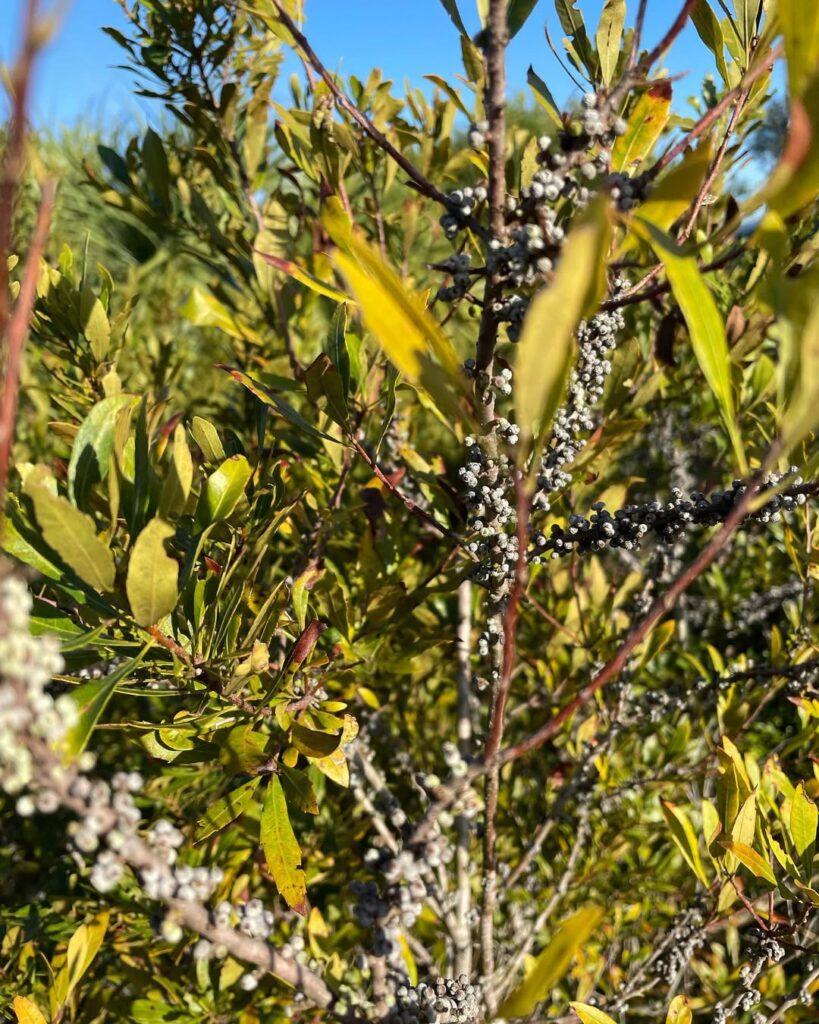
Southern Wax Myrtle stands as one of Georgia’s most versatile and valuable native shrubs, growing 6-12 feet tall with an attractive multi-trunked form and distinctive gray bark. This evergreen beauty features aromatic olive-green foliage and produces small bluish-gray berries on female plants that persist through winter, providing essential food for wildlife.
Beyond its ornamental appeal, Southern Wax Myrtle offers exceptional ecological benefits including nitrogen-fixing capabilities and excellent habitat value for birds and pollinators. Historically, colonists utilized the waxy coating of the berries to create fragrant-burning candles, making this native plant both beautiful and functional. Its adaptability to various growing conditions, from wet to dry soils and full sun to partial shade, makes it an ideal choice for low-maintenance landscapes, natural screens, and coastal plantings throughout Georgia.
- Hardiness: USDA zones 7-10
- Light: Full sun to partial shade
- Water: Tolerates dry to wet conditions; drought-tolerant once established
- Soil: Adaptable to sandy and clay soils; excellent salt tolerance
- Fertilizer: Minimal requirements due to nitrogen-fixing capabilities
- Pest/Disease Resistance: Excellent resistance with few serious issues
- Growth Rate: Moderate to fast growth rate
Beautyberry
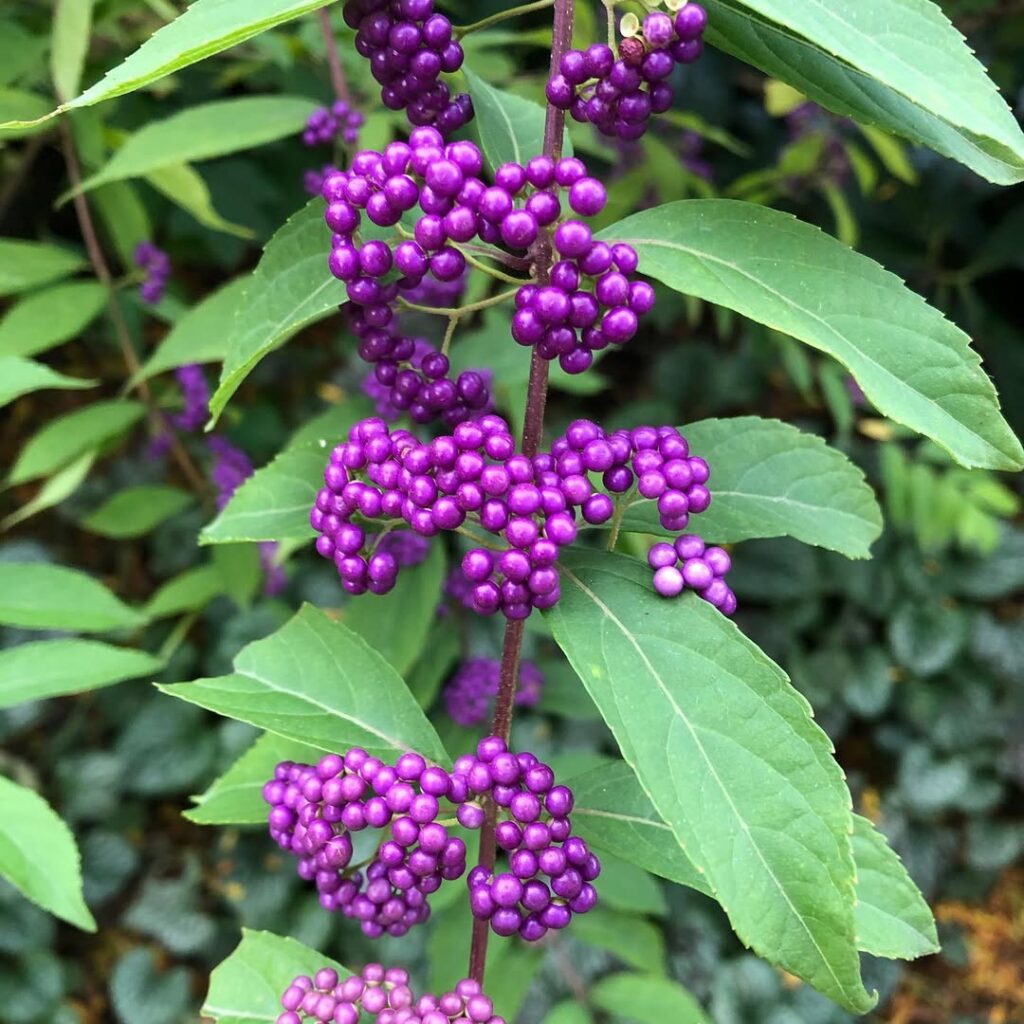
Beautyberry (Callicarpa americana) stands out as one of Georgia’s most distinctive native shrubs, prized for its spectacular display of magenta berry clusters that persist from August through November. This fast-growing deciduous shrub reaches 6-8 feet tall and wide, featuring pale pink-to-lavender summer blooms followed by the iconic spherical fruit clusters that give the plant its common name.
Beyond its ornamental value, beautyberry serves as a vital wildlife food source, attracting approximately 40 bird species during cold months along with mammals like opossums, raccoons, and squirrels. The plant thrives naturally in woodland clearings, right-of-ways, and upland sites throughout its native range. The plant also offers natural insect-repelling properties, with Native Americans and early farmers utilizing crushed leaves to ward off mosquitoes and other pests.
- Hardiness: USDA zones 6b-11
- Light: Full sun to part shade
- Water: Adaptable to various moisture levels; tolerates moist conditions
- Soil: Adaptable to sandy, clay, and various soil types
- Fertilizer: Low maintenance; typically doesn’t require supplemental feeding
- Pest/Disease Resistance: Excellent resistance; naturally repels insects
- Growth Rate: Fast-growing with drooping branch habit
Wild Azalea
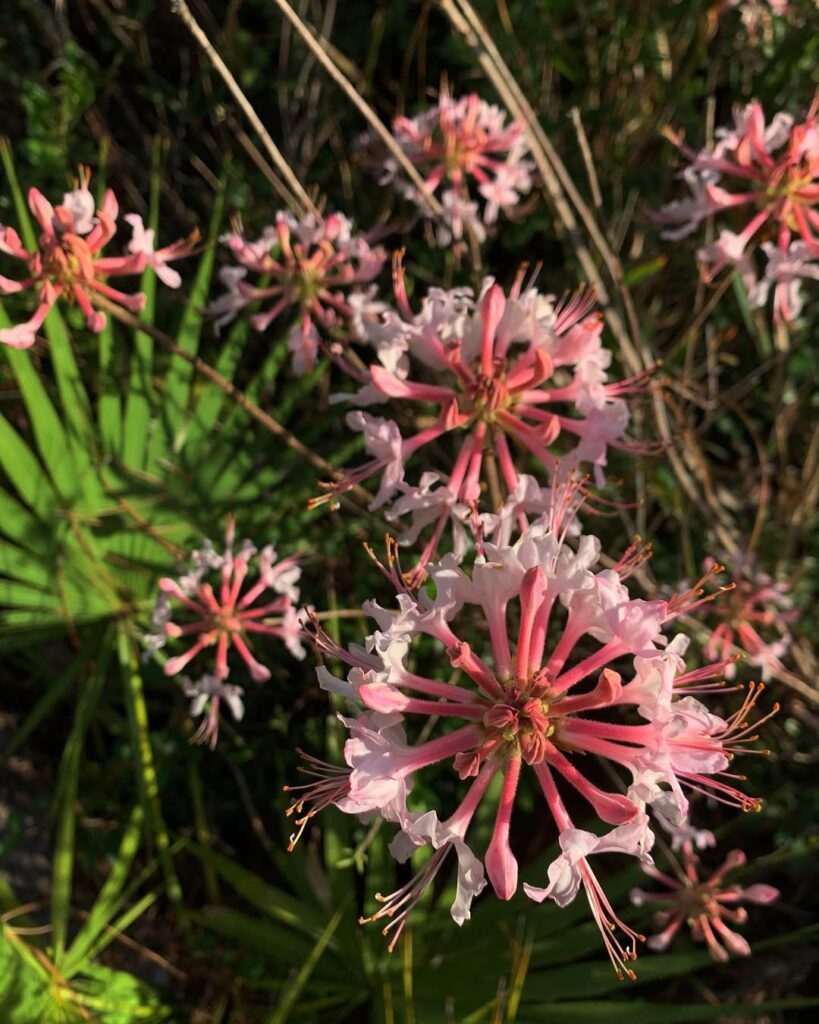
Wild azalea represents Georgia’s most spectacular native flowering shrubs, with the state boasting more native azalea species than anywhere else in the country. The Piedmont azalea, Georgia’s most common variety, creates stunning displays of fragrant white to pink blooms from March through May, earning it the nickname “bush honeysuckle.” These deciduous shrubs can reach impressive heights of 8-15 feet and form extensive colonies throughout the Coastal Plain and Piedmont regions.
Unfortunately, native azaleas are rapidly disappearing from their wild habitats, making conservation efforts essential. Despite this decline, they remain excellent ornamental choices for water gardens and naturalized landscapes, though gardeners should be aware that all parts of the plant are poisonous to humans and animals. Thanks to dedicated hard-working plantsmen in the 1960s, many azaleas were rescued before urban development and made available for gardens and natural areas.
- Hardiness: Zones 6-9, native to southeastern United States
- Light: Part shade; requires more light than some native azaleas for ideal blooming
- Water: Consistent moisture preferred; thrives near creeks, gullies, and moist areas
- Soil: Moist, well-drained, acidic soil; naturally found in acid bogs
- Fertilizer: Minimal requirements when grown in appropriate acidic conditions
- Pest/Disease Resistance: Generally resistant when grown in native conditions
- Growth Rate: Moderate; forms large colonies and hybridizes readily with other species
Selecting the Right Native Plants for Your Garden
Choosing the perfect native plants for your Georgia garden isn’t just about picking what looks pretty—it’s about understanding your specific growing conditions and matching them to plants that’ll actually thrive. Start by evaluating your soil drainage, since many natives like Wisteria Frutescens require well-draining conditions while others tolerate clay.
Consider your regional climate too. Mountain Laurel flourishes in north Georgia’s cooler conditions but struggles in southern heat. The native plant benefits include drought resistance and wildlife attraction, making species like American beautyberry and Black Cherry excellent choices for sustainable gardens.
Many native species also offer practical benefits beyond aesthetics, as crushed leaves from American beautyberry may repel mosquitoes naturally.
Frequently Asked Questions
Where Can I Purchase Native Georgia Plants Locally?
You can purchase native Georgia plants at local nurseries like Buck Jones Nursery, North Georgia Native Plant Nursery, and Cottage Garden Natives. Also check plant festivals hosted by nature centers and botanical gardens.
How Much Do Native Georgia Plants Typically Cost?
While you’re dropping fifty bucks on exotic houseplants that’ll die anyway, native plant pricing runs $13.95-$16.95 for quart-size Georgia natives. Cost comparison shows specialty varieties reach $26, but native plant society sales offer better deals.
What Pests Commonly Affect Native Plants in Georgia?
You’ll encounter aphids, Japanese beetles, and scale insects as major pests affecting native Georgia plants. Effective pest control includes encouraging natural predators, while plant diseases often develop from honeydew-producing insects and moisture stress.
When Is the Best Time to Plant Native Species in Georgia?
Georgia’s mild winters make fall your ideal window for native plantings. You’ll maximize success by following seasonal growth patterns during October-November, when these best planting seasons offer warm soil and cooler air temperatures.
Do Native Georgia Plants Require Special Fertilizers or Amendments?
You don’t need special fertilizers for Georgia natives since they’re adapted to native soil conditions. Test your soil first, then consider organic options like compost or slow-release fertilizers if nutrients are lacking.
